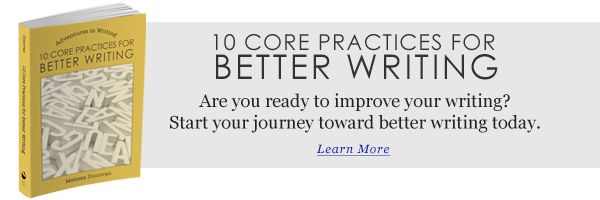I’d like to share a few excerpts from my book 10 Core Practices for Better Writing. “Chapter Three: Revision” explores the importance of revising your work and includes tips and ideas for editing and proofreading. Enjoy!
“The best writing is rewriting.”
– E.B. White
We use the terms first draft or rough draft when we are initially writing a piece because almost every single project is going to go through multiple drafts. But how is the drafting process tackled? And what are the benefits of multiple revisions?
Some writers love the revision process; others think it’s a drag. Regardless of how you feel about revising your work, one thing is certain: if you want to produce better writing (and become a better writer), then revisions are absolutely essential.
To revise means “to change” or “to alter.” In the world of writing, to revise means “to alter something already written or printed, in order to make corrections, improve, or update: to revise a manuscript.” (dictionary.com)
Revision involves making substantial changes to improve the writing. In fiction, this could mean changing characters’ names, realigning the plot, or resequencing the scenes. In other forms of writing, revision might entail major structural changes (moving chapters around) or a content overhaul (adding, removing, or changing information). Sometimes, revision involves rewriting a project entirely.
Revisions Improve Your Future Writing
As you revise, you catch things in your writing that don’t work. We all have bad habits, and as you go through multiple revisions, you’ll start to notice negative patterns in your own writing. Maybe you have a tendency to leave words out. Perhaps you use too many words (or too few). Maybe you repeat words too often or use obscure language that readers won’t comprehend. You could have grammar weaknesses, holes in the syntax, gaps in continuity, and a host of other problems that occur in writing.
Over time, revision teaches you what your weaknesses are. Early on, I realized that I had a problem with word repetition. I would notice a word used several times in a single poem. It didn’t sound right, so I fixed it by finding replacement words. Then I saw the same problem in another poem, then another, and another. Eventually, I started catching myself, not during the revision process, but during the initial writing.
And I realized that revising what I’d already written improved what I had yet to write.
We all want to achieve better writing, and there are many ways to do that. You can study the craft of writing, learn grammar, collect writing tips, and practice writing every single day. All of these things (and many more) will make your writing better. But revision is where you truly turn your writing into a dazzling piece of work.
Writing Methods and Revision Techniques
There’s more than one way to approach revisions.
Revising as You Go
If you have already developed your project, then revising as you go might be a good approach. For example, if you’re working from a detailed outline and have a good sense of what you want to communicate, you can focus on wording, grammar, and punctuation as you work through your first draft.
Some writers are compelled to edit as they write because poorly written sentences and typos weigh on them and make it difficult to move forward, or it might seem as if trying to get it right on the first draft will save time later, which is unlikely. Going over each sentence and paragraph several times before moving on to the next could very well be just as time consuming as going over an entire draft multiple times.
Draft First, Revise Later
A book is an enormous undertaking. Some writers spend several years on the first draft alone. For example, in a novel there’s a lot to think about: characters, plot, setting, scenes, action, dialogue, description, themes, and story arcs. Even if you have a basic sense of your story, once you start drafting, you’ll encounter all kinds of problems.
If you’re revising as you write, these problems get compounded and can seriously hold up your progress. If you’re simultaneously working on grammar, spelling, and punctuation or fine tuning the most minute details of every scene as you write the first draft, you’ll find yourself stopping every few words to make changes and fix mistakes, and you’re likely to lose your train of thought. When you’re deep in a scene, you could lose the entire flow because you’re worrying over minutia that could be dealt with later.
Most writers seem to get the best results by plowing through the initial draft and then revising several times. This allows ideas to stream without interruption. Then, through a series of revisions, the work is slowly improved until it’s polished. Some writers revise chapter by chapter, others revise scene by scene. I’ve heard writers say they do revisions for particular elements: one revision to fine-tune the plot and characters, one to strengthen the scenes, one for dialogue, and so on. This allows you to focus your attention on specific elements with each revision. Some writers work through the entire manuscript from beginning to end several times.
With the draft-first-revise-later method, every revision makes the manuscript better, resulting in a clean, polished project.
Activity
Find an old piece of writing that you haven’t worked on or looked at in a while. Save a copy of the original, and then open it in a word-processing program. Read through the entire piece once, then go back through a second time and make major changes to the structure and content. Move sentences and paragraphs around, make better word choices, fix issues with plot and character or concept. Then go through a third time and check strictly for grammar, spelling, punctuation, and typos. Use highlighting to mark sections you’re not sure about (such as whether you’re using a word properly or whether a sentence is technically correct). Wait a day, then review the original and the revised copies side by side. How much improvement were you able to make? Could you go over it a couple more times?






Hey, great article!
I find that there are a lot of useless writing advice blogs out there, but this article is definitely worthwhile and a great resource. Thanks for sharing.
Thank you!